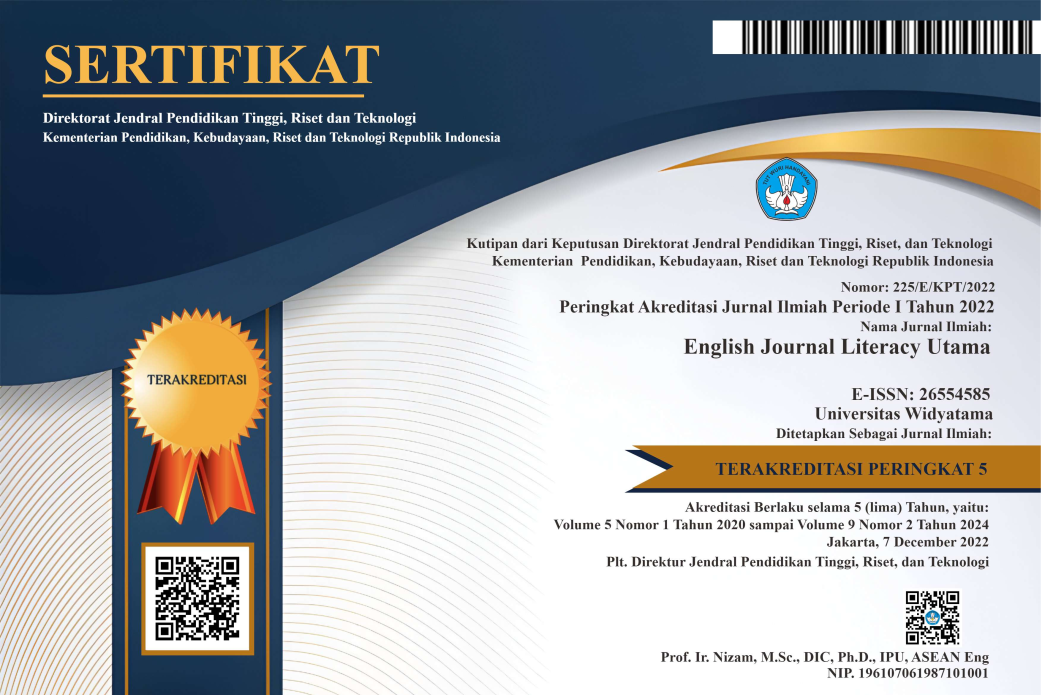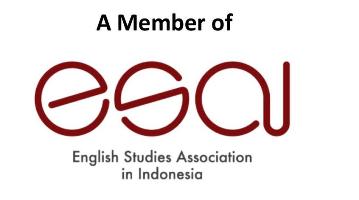MISPRONUNCIATION IN STUDENTS’ ENGLISH VIDEO PRESENTATION
DOI:
https://doi.org/10.33197/ejlutama.v8i2.253Kata Kunci:
mispronunciation, English, speaking, videoAbstrak
Mastering pronunciation, especially in speaking English, is crucial for effective communication in order to creates meaning. In Indonesia itself, English is considered a foreign language (L2) for Indonesian people who speak the Indonesian language as their mother tongue (L1). Thus, the differences in phonological features between English and Indonesian pose challenges for learners, particularly in pronouncing English words. This study explored the mispronunciations made by students in their job interview simulation video. This is a qualitative study conducted using the document analysis technique. Data were collected from the videos that were uploaded to Youtube or Google Drive by 25 students of International Trade major as an assignment in English for the International Trade course. The data collected were analyzed and classified into three types of mispronunciations proposed by Bonaventura et al. (2000). The results show that there are 72 words mispronounced, namely 23 words classified as Type 1: Problems in the pronunciation of non-native sounds, 24 words categorized as Type 2: Carry-over of pronunciation regularities from the mother tongue (L1), and 26 words classified as Type 3: Overgeneralizations of the target language (L2). It can be concluded that students still have difficulties in speaking English, and thus need more practice and be taught about pronunciation rules so that they can differentiate how each word is pronounced, instead of guessing how a word is pronounced. It is expected that the results of this study can help both students and teachers in improving students' speaking skills, particularly in pronunciation.
Referensi
Alwi, H., Dardjowidjojo, S., Lapoliwa, H., & Moeliono, A. M. (2003). Tata bahasa baku bahasa Indonesia. Balai Pustaka.
Bonaventura, P., Herron, D., & Menzel, W. (2000). Phonetic rules for diagnosis of pronunciation errors. Sprachkommunikation, Vorträge Der Gemeinsamen Veranstaltung, 5, 225–230.
Bowen, G. A. (2009). Document Analysis as a Qualitative Research Method. Qualitative Research Journal, 9(2), 27–40.
Creswell, J. W., & Creswell, J. D. (2018). Research Design: Qualitative, Quantitative, and Mixed Methods Approaches. (5th ed.). SAGE.
Gunantar, D. A., & Rosaria, S. D. (2020). Kesalahan Pengucapan Bahasa Inggris Pada Mahasiswa (Error Pronunciation). Jurnal Dinamika Sosial Budaya, 22(2), 272. https://doi.org/10.26623/jdsb.v22i2.2575
Leedy, P. D., & Ormrod, J. E. (2005). Practical research: Planning and Design (8th ed.). Pearson Education International.
Martanti, I. F. R. (2022). Pronunciation Errors in Students’ Vlog Projects. Acitya: Journal of Teaching and Education, 4(1), 252–265. https://doi.org/10.30650/ajte.v4i1.3221
Megariani, Y. M., Listyantari, N. A., & Bram, B. (2020). Mispronunciations in Graduate Students’ Presentation Projects. Metathesis: Journal of English Language, Literature, and Teaching, 4(1), 56. https://doi.org/10.31002/metathesis.v4i1.1879
Rajadurai, J. (2007). Intelligible pronunciation: Focus on the proficient L2 speaker. The Journal of Asian TEFL, 4(1), 1–25.
Seidlhofer, B. (2001). Pronunciation. In R. Carter & D. Nunan (Eds.), The Cambridge Guide to Teaching English to Speakers of other Languages (pp. 56–65). Cambridge University Press.
Steinhauer, H. (2000). Bahasa Indonesia dan Bahasa Regional di Indonesia. In Kajian Serba Linguistik: untuk Anton Moeliono Pereksa Bahasa (pp. 175–195). Gunung Mulia.
Unduhan
Diterbitkan
Terbitan
Bagian
Lisensi
Hak Cipta (c) 2024 Gartika Rahmasari, Iris Fatia Maharani

Artikel ini berlisensiCreative Commons Attribution-NonCommercial-ShareAlike 4.0 International License.
Creative Commons Attribution-ShareAlike 4.0 International License















